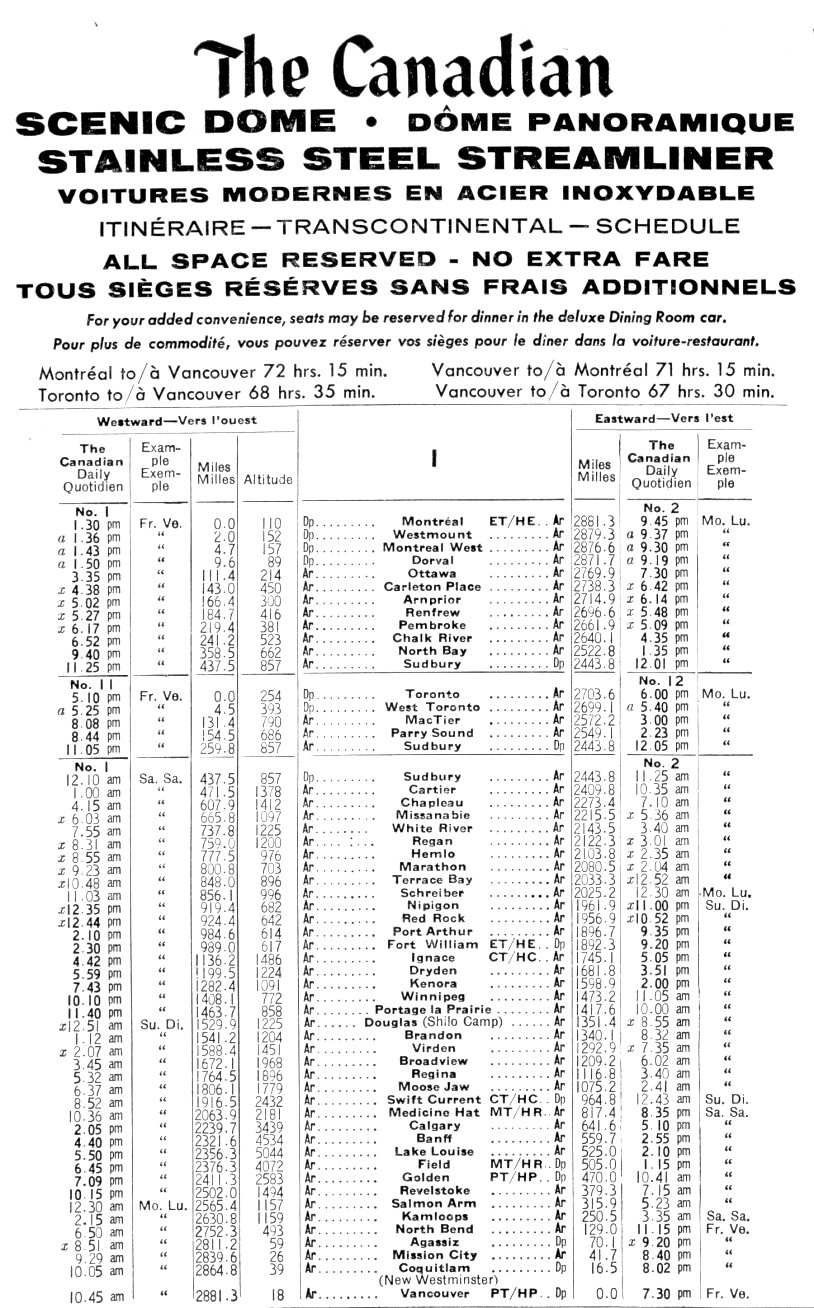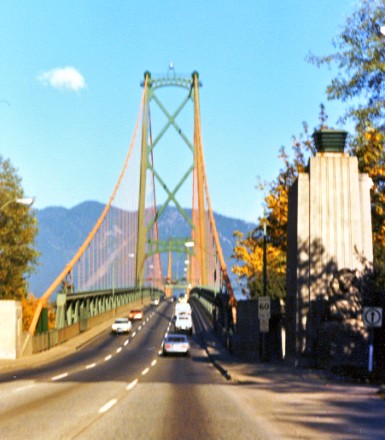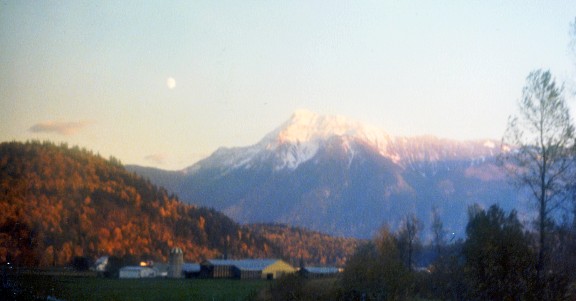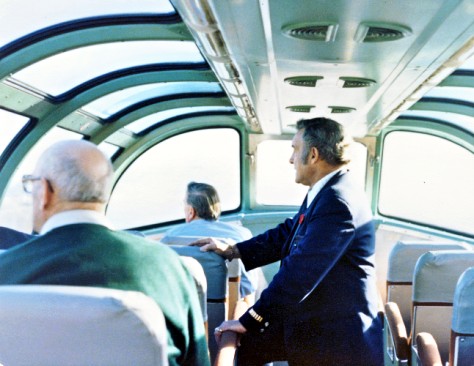Across Canada by Train
Eastbound on The
Canadian in 1979
Part 1 - Vancouver to Winnipeg
In 1979 I crossed Canada by train. Westbound I took CNR's Super
Continental.
The return trip was on the train known as The Canadian
-
the Canadian Pacific's premier passenger train, which first ran in the
mid-1950s.
New and unusual traffic patterns in the 1960s ... and
miscalculations
For a number of years during the 1960s, Canada was planning for its big
Centennial of
Confederation celebration in 1967. During the mid-1960s,
many people went across Canada by train for the first time -
particularly
those travelling to Expo 67 in
Montreal during the Centennial year
itself. Passenger trains were lengthened and extra trains were
scheduled to meet the demand that year.
The Trans-Canada Highway had recently been completed north of Lake
Superior and automobiles expanded their dominance of land
transportation - now possible from coast to coast on an all-Canadian
route.
Canada
... or 'the nation of' Quebec
... or Montreal ...
depending on who is writing the history ...
"burst onto the world stage" with Expo
67.
"The whole world", and much of Canada, came to Montreal during the
summer of 1967.
What a future we proud Montrealers had !
Perhaps because of this euphoria, overly optimistic bureaucrats were
extrapolating their 1967
traffic graphs a little too far ... the 1969 blizzard of expropriation
orders for houses and farms in the Ste-Scholastique area was soon
to blow. The only thing that blew harder was the trumpetting Jumbo
white elephant
airport ... subsequently built there at great expense ... Mirabel
International.
Meanwhile, in the ferro-pachyderm department was Canadian National
Railways' Turbotrain - "built
with blueprints in one hand and a hammer
in the other". Promised, but not ready in time for 1967.
The Canadian Pacific 1966 Timetable
During those years, the railways were still generally proud of their
tried and true
transportation traditions ... but Canadian
Pacific's sombre, black-covered 1966 public timetable suggested the
grand days of rail passenger travel were gone ... regardless of
the CPR's historic association with Macdonald's 'National Dream' and
Canada's growth and development ... and therefore the 1967 Centennial
celebration.
The idea of a bilingual public timetable saved money.
Perhaps it also suggested
that the "Two
Solitudes" (i.e. descendants of "Canada's Two Founding
Nations" - France and ... um ... Scotland ?) were coming
together for a national celebration, just like
bolted rail butts on a warm and sunny summer day.
Here is the 1966 timetable of the classic CPR
Canadian.
Westbound, read down the left side.
Eastbound, read up the right side.
Canada in the 1960s ... krazy
fun facts:
- Traditionally, many
anglophones "learned a second
language" by reading these new-fangled bilingual timetables and
breakfast cereal
boxes. If you're not Canadian, try it yourself - it's fun and easy!
- Traditionally, francophones
who worked in the CPR Angus
Shops (Montreal) were required to communicate with their superiors and
the company only in
English.
- Traditionally, working class
Quebec separatists cite their
fathers' various "English immersion" workplace experiences as a major
influence ... launching
them into political action to protect their identity.
As you may have noticed above,
The Canadian originated in Canada's historic railway capital -
Montreal.
It's poor, shorter cousin from Toronto met it in Sudbury where
switching operations took place.
When I travelled in 1979, VIA Rail (a government "crown corporation"),
had
recently taken over responsibility for most passenger rail service in
Canada.
Even so, the proud culture of CPR's great passenger train was largely
still in place as you'll see.
Eastbound on The Canadian
1979
Beautiful weather on the southern approach to the Lion's Gate Bridge at
Vancouver.
At the beginning of November, the
autumn colours are showing.
The
Canadian has left Vancouver and the train is travelling up the Fraser
Valley.
The sun to our backs reflects off the snowy mountain top and
the moon.
Using all CPR stainless steel equipment, I assume the sleeping car
containing my roomette was wired through to the dining car, where I
assume
the public address and music equipment locker was located. Including
many subsequent trips on The Canadian, this was the only
time a roomette's public address and music selector knobs could be set
to bring sound into the individual sleeping car rooms.
In fact, after
the first night, nothing ever came through the speakers again.
It was
nice to get an idea of how luxurious the train had been in earlier
years with PA announcements for trackside scenery,
the various sittings for dinner
in the 'Dining Room Car'
and music to soothe the savage rail traveller.
FIRST
NIGHT ON THE TRAIN
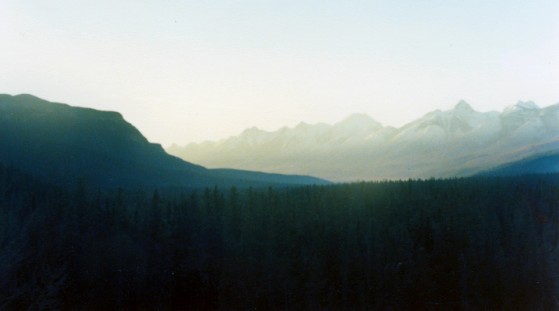
The next morning, I was up early
to see
the first available Rocky Mountain scenery.
Just after the crew change
point of Field, British Columbia I was in the rear dome as we went
through the Spiral Tunnels and continued up the "Big Hill" to the
Continental Divide. A wonderful travelling companion would be present
in the Park observation car between Field and Medicine Hat. At that
hour, we were pretty much alone in the dome and quickly struck up a
conversation. Many years later, his name was mentioned at some railway
fan event, and I regret
that I didn't record it so I could pass it on to you today.
|
September
2010
Brent Fritzke
also worked out of the same Medicine Hat terminal (as the trainman
pictured) retiring last summer with 34 years of service.
When visiting this website, he was kind enough to drop me a line to
indicate that our tailend trainman's name was Mars Wolf.
Thank you Brent.
|
Much later in the day, you can see him here in the dome, still doing
his
thing. A Medicine Hat based trainman,
you can recognize over 35 years
of railroading from the service bars on his immaculate CPR uniform,
complete
with a Remembrance Day poppy.
In addition to his usual light (unless
something went wrong) duties as a
tailend trainmen,
he spent his entire
trip proudly pointing out and interpretting the various attractions.
You can just imagine the storms and emergencies he had worked through
during all those years of service.
During
several trips across Canada I/we never experienced a CPR CNR or VIA
employee
with the interest or pride displayed by this "old school" CPR
professional.
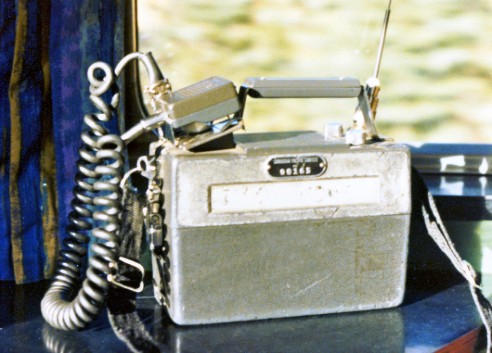
The trainman's friend.
Back in Schreiber, hopping up onto moving boxcars from deep snow was
always more fun when you had three lantern batteries strapped around
your neck!
This was the standard issue CPR Motorola 5 watt portable radio a
trainman usually had with him.
When they finally failed, they were probably reissued to Maintenance of
Way personnel to tap in loose spikes.
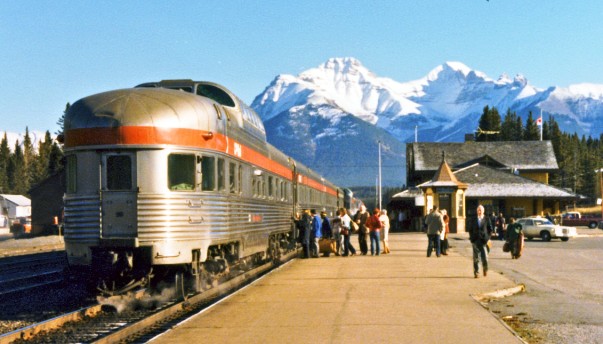
The Canadian stops at Banff, near the famous CPR Banff Springs Hotel.
Notice that VIA has removed the CP
Rail The Canadian illuminated drumhead sign from the rear door.
Three young women in identical ski jackets have just boarded and they
will join us in the dome.
They are from Australia.
Every long distance train in Canada has at least one Australian aboard.
I've concluded some old Board of Transport Commissioners regulation
requires it.
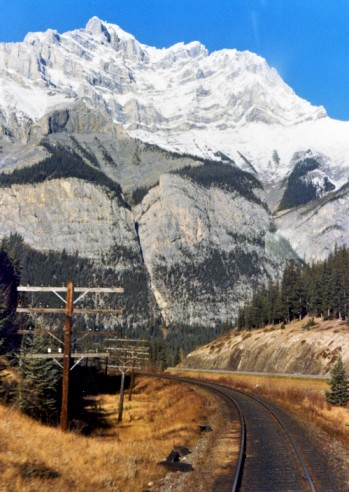
The Trans-Canada Highway decides to follow us for a short while.
Does it have a choice ?
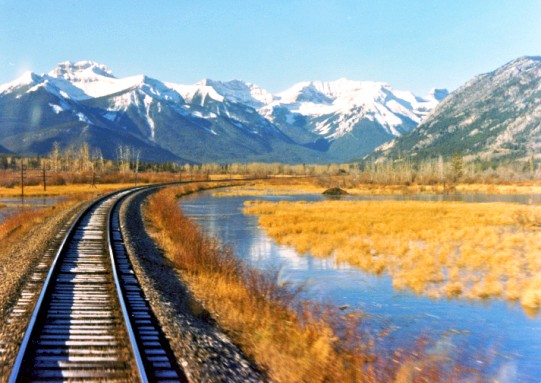 Just shoot out the rear window every now and then ...
Just shoot out the rear window every now and then ...
The scenery is provided by the CPR.
Notice the beaver dam and the frosty ties.
Shown about 95 years after it was graded ...
how many people and tons of freight have travelled along this simple
little earthen embankment ?
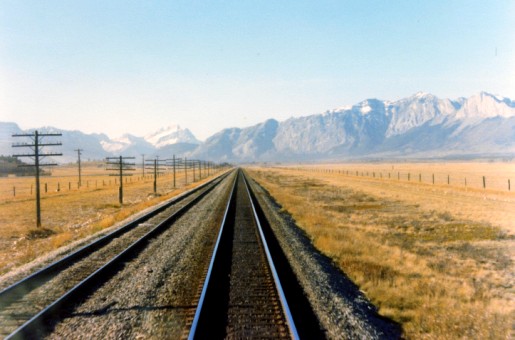 Leaving the foothills, we're making good time.
Leaving the foothills, we're making good time.
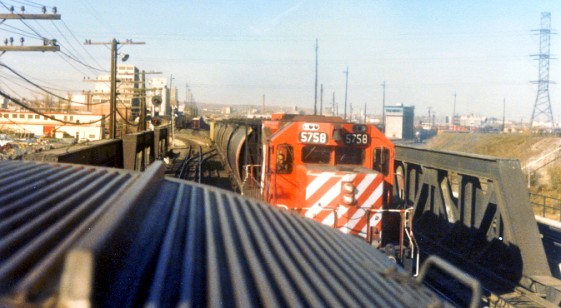 Threading our way through the tracks of Calgary.
Threading our way through the tracks of Calgary.
This is taken from the rear of the dome.
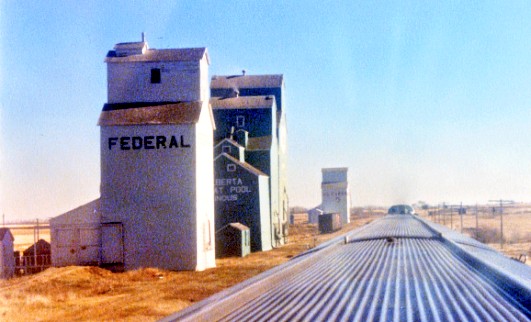 Diesel smoke rises ahead of the Skyline Dome.
Diesel smoke rises ahead of the Skyline Dome.
We're at Indus, just east of Calgary.
Notice the boxcars on the elevator lead.
My guess is that the shed at the extreme left once housed a kerosene
and water "hit and miss" engine.
Firing intermittently to satisfy a centrifugal governor (long before
electricity was available here) it drove a large flywheel.
A heavy leather belt connected the flywheel to the inner workings of
the grain elevator
- everything was as ingenious and efficient as a pocketwatch.
Keeping sparking engines in a separate shed, away from combustible
grain dust suspended in air,
helped prevent splintered elevator timbers from littering the mainline.
 The tailend trainman took me down to the vestibule with him to
celebrate a human resources event.
The tailend trainman took me down to the vestibule with him to
celebrate a human resources event.
We, Train Number 2,
are in a siding for Train Number 1 -
which left Montreal about 2 days ago.
The engineer of Number 1 is just a few dozen miles from retiring in
Calgary ... and he was moving !
Consider the importance to an old time CPR engineer of bringing his
last train in safely ... but on time.
Doing a rough conservative calculation today, he had covered over
500,000 miles during his career.
One million kilometres would be possible - and that sounds more impressive if you
are telling a story.
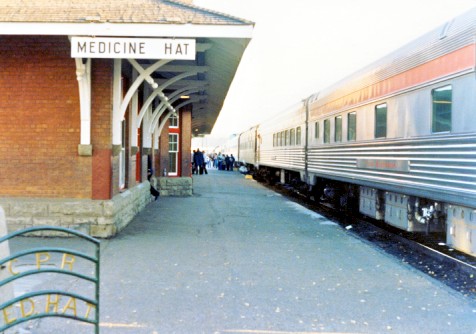 Our exceptional trainman leaves us as the operating crew changes.
Our exceptional trainman leaves us as the operating crew changes.
Many people are milling around the headend of the train where the
bus-like coaches provide economical medium distance transportation.
A worker leans out of the hot and busy dining car kitchen door for a
breath of fresh cool air.
Notice the little touches the Classic CPR applied: "CPR Med Hat" at the
left.
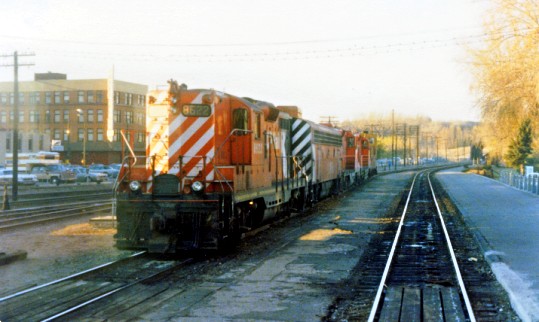 Some power, with a van attached, idles in the late autumn sun at
Medicine Hat as we start to pull.
Some power, with a van attached, idles in the late autumn sun at
Medicine Hat as we start to pull.
All night, we raced across the Prairies.
SECOND NIGHT ON
THE TRAIN
Good Morning !
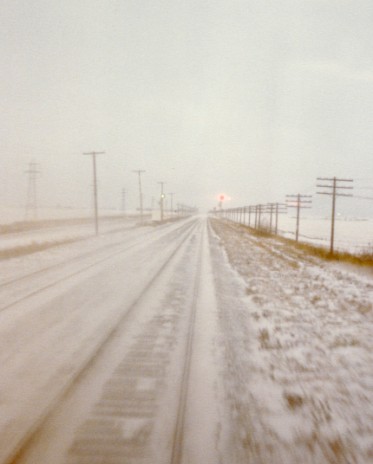 After basking in the sun in Alberta, we were in for a little shock
the next morning.
After basking in the sun in Alberta, we were in for a little shock
the next morning.
The dome car itself was cold and drafty as I took this shot.
We are running between Portage la Prairie and Winnipeg on CNR's double
track mainline.
Here is the 1979 public timetable
which made the trip with me, showing the CPR route, Vancouver to
Winnipeg, and approximate times.
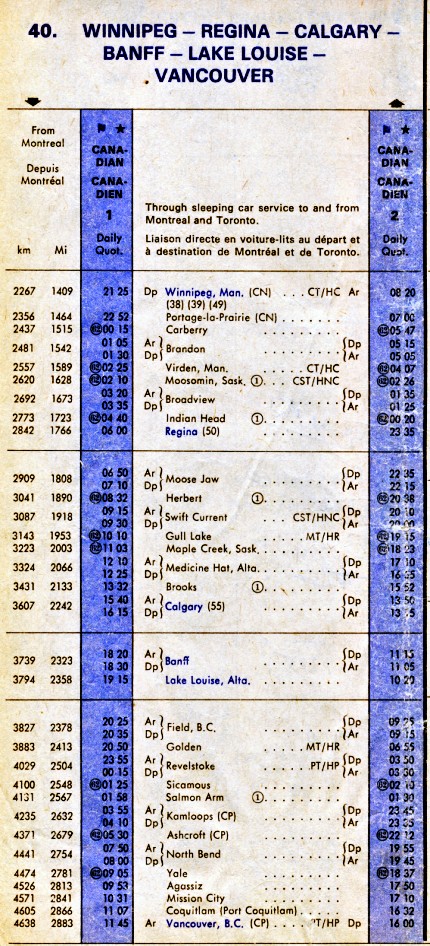
WINNIPEG
 Tramping around in the snow in my running shoes, I
photographed a rebuilt GMD1
as it switches our train just "west" of Winnipeg's Union Station.
Tramping around in the snow in my running shoes, I
photographed a rebuilt GMD1
as it switches our train just "west" of Winnipeg's Union Station.
(This class was originally
designed as a unique Canadian prairie branchline
locomotive with 12 wheels {A-1-A trucks} to distribute weight on very
light rail)
The Assiniboine River is moving away from us as it flows into the Red
River just behind the dome car.
The car at the left is the dining car.
I am travelling in the centre car, Chateau Maisonneuve.
The dome car is Kootenay Park.
YE OLDE UNION
STATION
(flat building at left with centre dome)
from a CGR "notes by the way" booklet - sometime between 1916 and 1918
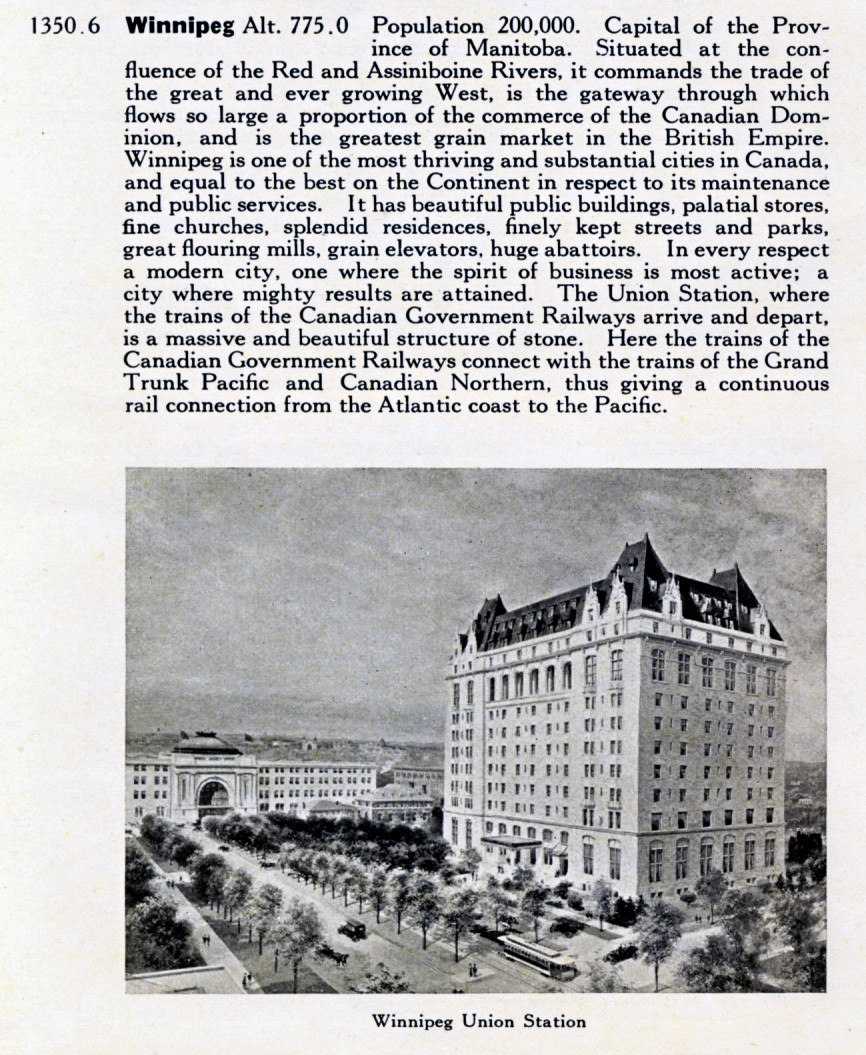 Back to
sitemap
Back to
sitemap
